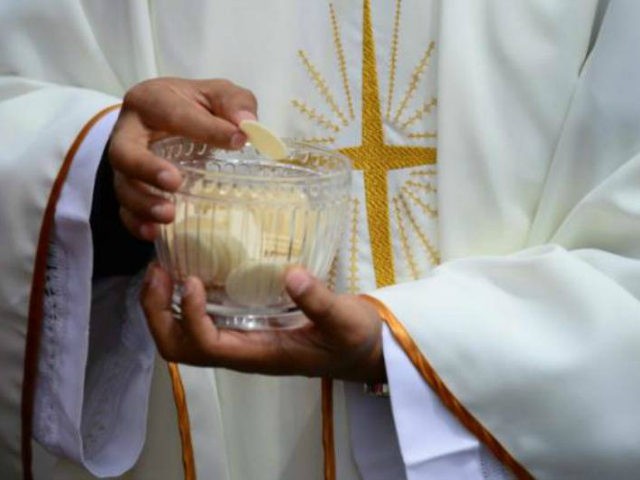The far-left New York Times was forced to issue a humiliating correction this week after describing “the body of Christ” as a statue.
The story by Elian Peltier was titled “The Chaplain, the Cathedral Fire and the Race to Rescue Notre-Dame’s Relics” and offered a detailed account of Father Jean-Marc Fournier (the Paris Fire Department chaplain) and his heroic efforts to save cherished Notre Dame’s treasures and relics during that devastating fire.
In the second paragraph, the Times quotes him as saying, “I had two priorities: to save the crown of thorns and a statue of Jesus.”
The Times goes on to offer breathtaking details about Fournier and his team’s effort to rescue this important statue.
“As the chaplain began removing a statue of Jesus, he said, his colleagues were fighting the fire from the cathedral’s towers,” the Times reports. “With the statue in hand, Father Fournier, alone in the nave, gave a benediction to the cathedral, he said.”
Great reporting. Captivating stuff. Except…
There’s no statue of Christ in Notre Dame.
No.
Statue.
So what happened? What was the Times talking about?
The correction, added to the story later, finally solved the mystery: “An earlier version of this article misidentified one of two objects recovered from Notre-Dame by the Rev. Jean-Marc Fournier. It was the Blessed Sacrament, not a statue of Jesus.”
It wasn’t a statue of Christ, y’all — it was the Blessed Sacrament, the Communion bread, the wafer… And, of course, this would be a top priority for Fournier. In fact, a priority over even the crown of thorns.
Here’s what likely happened… When the French-speaking priest spoke to the French-speaking Times reporter — in other words, this was not a language problem — the priest said he was primarily concerned with saving the crown of the thorns and the Body of Christ, and the secular Times reporter, who obviously has no education whatsoever about even the basics of a religion practiced by a billion-plus people, a religion that helped to usher in Western Civilization, believed the “Body of Christ” could only be the literal body of Christ in the form of a statue.
And this is what happens when your newspaper is a closed, secular echo chamber, one so closed and secular, this article managed to make its way through the Times‘ legendary “layers and layers of fact checkers” without coming across the desk of even one person who practices the Faith, or one person who knows enough about the elementary basics of a world religion that would allow them to catch an error literally everyone in my neighborhood would have immediately corrected.
And where was that journalistic instinct to say, Why is he saying ‘body of Christ’ instead of statue? Maybe I should look into this.
I’m sure the French do have a word for statue — something like foolaylasurrender — so wasn’t that a tip-off?
This is the exact same kind of know-nothing ignorance we saw from New York Times reporter Maggie Haberman this week when she freaked out after learning the song Edelweiss had been played at the White House.
Because Haberman lives in her own nepotistic bubble of Manhattan privilege, she only associates the song with a current water cooler TV show about Nazis, as opposed to The Sound of Music, a common and coarse movie made for a common and coarse population. To this elite, over-educated nitwit, Edelweiss can only be a Nazi anthem, when, of course, it is the exact opposite, which is why Haberman has even failed to grasp how her own water cooler show (The Man in the High Castle) uses the song.
What’s more, this is not the first time the Times has proved it is a closed, secular bubble.
Here’s a handy list, courtesy of the New York Post:
In 2013, the Times was forced to issue this humiliating correction: “An earlier version of this article mischaracterized the Christian holiday of Easter. It is the celebration of Jesus’ resurrection from the dead, not his resurrection into heaven.”
In 2014, the paper reported that “Nearby, the vast Church of the Holy Sepulcher marking the site where many Christians believe Jesus is buried, usually packed with pilgrims, was echoing and empty.”
Uhm, no Christian believes Jesus is buried. To be a Christian is to believe in the resurrection of Jesus.
Again in 2014: “An earlier version of this article misquoted a comment from Malachy McCourt on St. Patrick. Mr. McCourt said, ‘My attitude is, St. Patrick banished the snakes from Ireland, and they all came here and they became conservatives.’ He did not say St. Patrick banished the slaves from Ireland.”
When describing the 2005 funeral of Pope John Paul II, the Times wrote, “Tucked under his left arm was the silver staff, called the crow’s ear, that he had carried in public.”
What the Times is actually describing is a ceremonial staff called the “crosier” or “crozier.”
I’m not preening here. I make mistakes. It happens. But this is basic stuff, common knowledge … well, if you’re a commoner like myself. And this is the New York Times making these unforced errors, an outlet that should, at the very least, know what it doesn’t know, and rather than guessing, should take the time to find out.
I may confuse James Marsden and James McAvoy (come on, who doesn’t?), but if I’m writing about something exotic in my world, like Islam or country music, that’s what the Google Machine is for, or one of my Breitbart News colleagues, because — unlike the Times — we have a wide range of education, background, and experience on staff.
What happened to the Times is what happens when your idea of “diversity” is literally only skin deep.
Follow John Nolte on Twitter @NolteNC. Follow his Facebook Page here.

COMMENTS
Please let us know if you're having issues with commenting.